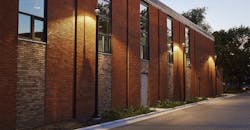Lighting Retrofit Enhances Historic Chicago Residential Complex
Chicago-based Julia Lathrop Homes was constructed as a public housing development during the Great Depression era. The 35-acre complex on the north shore of the Chicago River had degraded substantially over the years, so it was earmarked for a substantial transformation and modernization.
Plans included the restoration of the original 1938 buildings and revamping of parking, driveways, walkways, and surrounding green space down to the river. The new neighborhood was rebranded as “Lathrop” and now includes 1,116 units of mixed-income housing.
Developers wanted to stay true to the designs of the original architects. While the interior units were renovated to modern-day standards, there was a focus on restoring building exteriors, including brickwork and limestone pillars, to their former glory.
Tree-lined front lawns and paved space for resident parking in the back of each building were also included in the architects’ original designs. Pathways are prominent, guiding pedestrians between buildings, parking lots, a new children’s playground, and 11 acres of green space.
Luminis fixtures were ultimately selected by the lighting designer at CharterSills to illuminate the driveways and walkways throughout the residential complex while complementing the original architectural design of Lathrop.
“We were looking for a pole fixture with a clean, architectural profile that didn’t compete with the surrounding landscaping,” says Erin Held, design director at CharterSills, and lighting designer for the project. “And we wanted a luminaire that offered multiple distributions.”
Held selected the company’s luminaires with Type III distribution for the fixtures adjacent to the residential buildings, ensuring there was enough light pushed down to the nearby pathways without residual glare directed at the residence windows. Fixtures further along the paths and driveways feature a Type V distribution, where light is equally dispersed to the ground below, providing a safe, well-lit environment.
The luminaires also have a 3000°K color temperature, so residents and guests experience a warm illumination as they enter the complex.
Each of the 65 luminaires is affixed to a 5-in. diameter round aluminum pole designed to offer maximum resistance to wind load. The components are made of a corrosion-resistant aluminum alloy and hardware is stainless steel, with a powder coating, to protect against Chicago winters.
Developers will also be seeking LEED and Enterprise Green Communities certifications in the affordable housing sector category.
